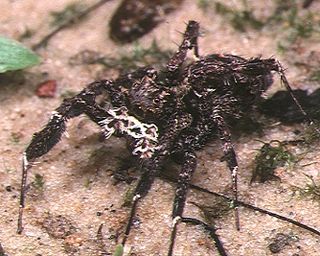Aillutticus is a genus of South American jumping spiders that was first described by María Elena Galiano in 1987.
Amatorculus is a genus of South American jumping spiders that was first described by G. R. S. Ruiz & Antônio Domingos Brescovit in 2005. As of June 2019 it contains only two species, found only in Brazil and French Guiana: A. cristinae and A. stygius.
Amphidraus is a genus of South American jumping spiders first described by Eugène Simon in 1900. It was previously considered a synonym of Nebridia, but this was later rejected by Jerzy Prószyński, who claimed that merging the two genera wasn't supported by previous diagnostic drawings.

Breda is a genus of jumping spiders that was first described by George Peckham & Elizabeth Peckham in 1894.
Helvetia is a Neotropical genus of the spider family Salticidae. The genus name is derived from Helvetia.
Kalcerrytus is a genus of spiders in the jumping spider family, Salticidae.
Nosferattus is a genus of Brazilian jumping spiders that was first described by G. R. S. Ruiz & Antônio Domingos Brescovit in 2005. The name is a combination of "Nosferatu" and the ending -attus, a common salticid genera suffix.

Pachomius is a genus of jumping spiders that was first described by George and Elizabeth Peckham in 1896. Uspachia was merged into genus Romitia in 2007, and all nine species were merged into Pachomius in 2015. The name is derived from Pachomius, the founder of cenobitic monasticism.
Platypsecas is a monotypic genus of Venezuelan jumping spiders containing the single species, Platypsecas razzabonii. It was first described by Lodovico di Caporiacco in 1955, and is only found in Venezuela. The type locality is El Junquito in the Capital District. Gustavo R. S. Ruiz and Antonio D. Brescovit though the genus was "possibly in Euophryinae"; Wayne P. Maddison followed their "tentative suggestion" and classified the genus in the tribe Euophryini within the clade Saltafresia and subfamily Salticinae.

The Spartaeinae are a subfamily of the spider family Salticidae. The subfamily was established by Fred R. Wanless in 1984 to include the groups Boetheae, Cocaleae, Lineae, Codeteae and Cyrbeae, which in turn were defined by Eugène Simon.
Edilemma is a monotypic genus of Brazilian jumping spiders containing the single species, Edilemma foraminifera. It was first described by G. R. S. Ruiz & Antônio Domingos Brescovit in 2006, and is only found in Brazil.
Capeta tridens is a species of jumping spider in the family Salticidae. It is found in Brazil.
Onofre is a genus of Brazilian jumping spiders that was first described by G. R. S. Ruiz & Antônio Domingos Brescovit in 2007. As of August 2019 it contains only three species, found in the Amazon basin of Brazil: O. carnifex, O. necator, and O. sibilans. They are related to members of Chira, and the three species were described from the states of Mato Grosso and Pará. The generic name is a common man's name in Brazil.
Matagaia is a genus of jumping spiders. Its only species, M. chromatopus, was only found on Fernando de Noronha Island, an isolated group of volcanic islands located in the South Equatorial Atlantic, about 350 km from the nearest Brazilian mainland.
Gavarilla is a genus of Brazilian jumping spiders that was first described by G. R. S. Ruiz & Antônio Domingos Brescovit in 2006. Females are 3.5 to 5 mm long, with males 3 to 4 mm.

Caponiidae is a family of ecribellate haplogyne spiders that are unusual in a number of ways. They differ from other spiders in lacking book lungs and having the posterior median spinnerets anteriorly displaced to form a transverse row with the anterior lateral spinnerets. Most species have only two eyes, which is also unusual among spiders. A few species of Caponiidae variously have four, six or eight eyes. In some species the number of eyes will increase when the spiderling changes its skin as it grows towards adulthood.

Wanda Wesołowska is a Polish zoologist known for her work with jumping spiders. She has described more species of jumping spider than any contemporary writer, and is second only to Eugène Simon in the history of arachnology. Originally a student of ornithology, she developed an interest in jumping spiders while still a student at the Siedlce University of Natural Sciences and Humanities in the 1970s.
Druzia is a monotypic genus of Brazilian jumping spiders containing the single species, Druzia flavostriata. It was first described by G. R. S. Ruiz & Antônio Domingos Brescovit in 2013, and is only found in Brazil.

The Sitticini are a tribe of spiders in the family Salticidae. The tribe has been divided into two subtribes, Aillutticina, with five Neotropical genera, and Sitticina, with five genera from Eurasia and the Americas. One genus is unplaced within the tribe. The taxonomy of the tribe has been subject to considerable uncertainty. It was clarified in 2020.





